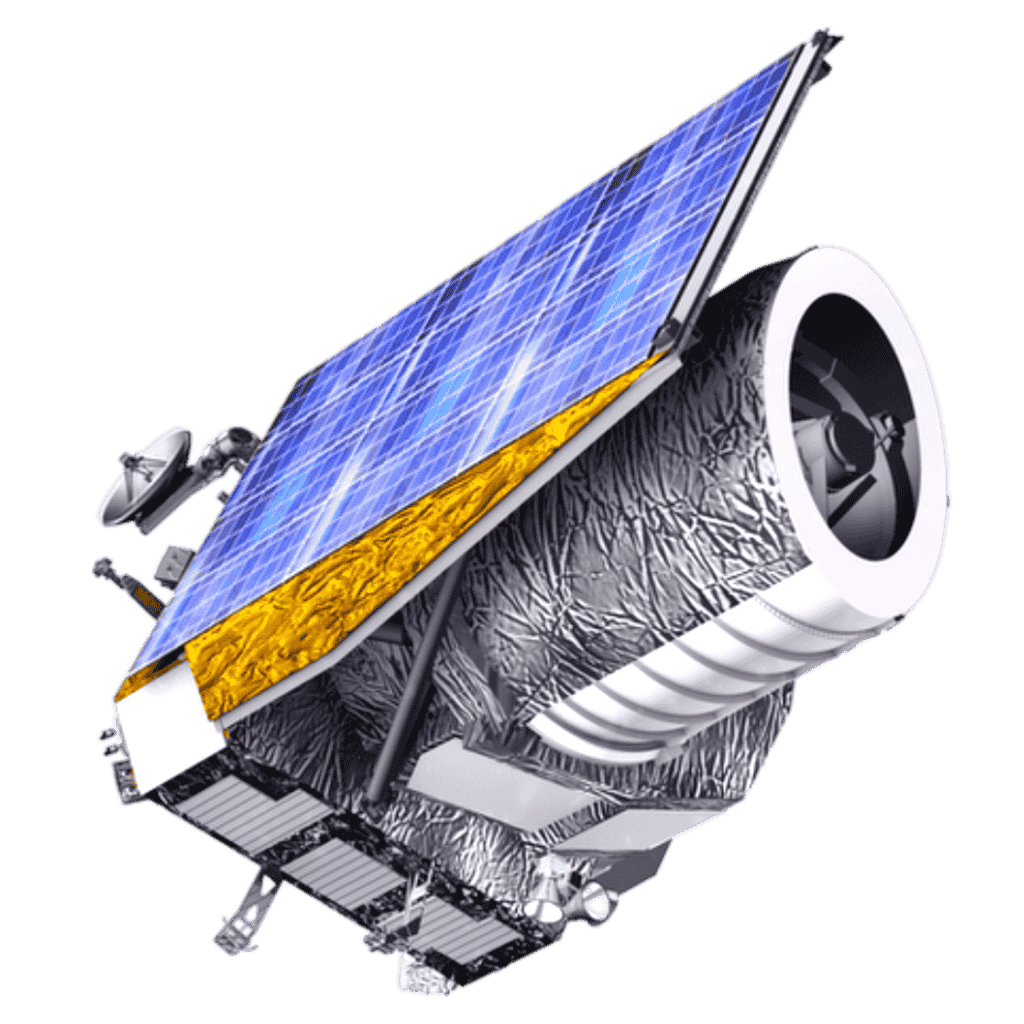Euclid Space Telescope
Dark Universe Explorer
Telescope studying dark energy and dark matter

USPs
- Wide-field surveys of billions of galaxies
- Studies dark energy via gravitational lensing
- Maps the universe’s geometry
- High-resolution imaging in visible and near-infrared
- Creates a 3D map of cosmic structures
- Supports synergy with Roman and JWST missions
- Advanced data processing for rapid public releases
Major Milestones
- 2023-07-01: Launched aboard a SpaceX Falcon 9 rocket from Cape Canaveral, initiating its mission to map the universe's large-scale structure and dark energy.
- 2023-07-07: Arrived at the Sun-Earth L2 point and began its six-month commissioning phase, deploying its 1.2-meter mirror and instruments.
- 2023-11-06: Completed commissioning, achieving first light with its visible and near-infrared instruments, confirming operational readiness.
- 2024-02-07: Began its six-year survey mission, starting with observations of galaxies in the southern sky to measure cosmic expansion.
- 2024-05-23: Released its first full-color images, showcasing galaxy clusters and distant galaxies with unprecedented detail.
- 2024-08-19: Detected its first gravitational lensing effects, providing early evidence of dark matter distribution across the universe.
- 2024-11-12: Published initial data from the first year of observations, including over 100 million galaxy measurements.
- 2025-02-01: Expanded its survey to the northern hemisphere, enhancing the 3D map of the universe's structure.
- 2025-06-15: Reported new insights into dark energy, refining cosmological models based on two-year data accumulation.
- 2025-07-17: Celebrates two years of operation, continuing to map billions of galaxies and support dark matter and dark energy research.
- 2025-08: Released first public catalog of galaxy shapes and distances, enabling global research collaborations.
Cosmic Portrait
Euclid: Probing the Dark Universe
Euclid, launched by the European Space Agency (ESA) in July 2023, is a next-generation space telescope designed to unravel two of the most profound mysteries in modern astrophysics: dark energy and dark matter. With its cutting-edge optics and dual-instrument payload, Euclid is on a mission to chart the geometry of the dark universe, offering new clues about how cosmic structures form and evolve over time.
- Primary Mission: Euclid aims to create the most detailed 3D map of the universe ever attempted, covering over one-third of the sky and cataloging more than two billion galaxies. By studying the distribution and shapes of these galaxies, the mission will measure how cosmic expansion has changed over the last 10 billion years.
- Scientific Methodology: The telescope employs two powerful techniques: weak gravitational lensing and baryonic acoustic oscillations. Weak lensing tracks how the light from distant galaxies is subtly distorted by intervening dark matter, revealing its distribution. Baryonic acoustic oscillations, on the other hand, help trace the large-scale structure of the universe and how it has expanded under the influence of dark energy.
- Technology & Instruments: Euclid is equipped with a visible light imager (VIS) and a near-infrared spectrometer and photometer (NISP). This combination enables it to observe the sky in multiple wavelengths, gathering detailed shape, redshift, and distance data from galaxies stretching billions of light-years away.
- Stable Orbit: Like many deep-space observatories, Euclid operates from the second Lagrange point (L2), a gravitationally stable spot approximately 1.5 million kilometers from Earth. This location provides a cold, stable, and unobstructed view of the universe, perfect for the kind of ultra-sensitive observations Euclid requires.
- Precision Surveying: Over its six-year mission duration, Euclid is expected to scan 15,000 square degrees of the sky—roughly 36% of the celestial sphere—with exquisite precision. It will collect petabytes of data, which will be analyzed by a large international consortium of researchers.
Scientific Impact and Legacy
As of 2025, Euclid’s early data releases are already shedding light on the structure and dynamics of the cosmos. Initial findings include refined measurements of galaxy clustering, improved models of dark matter halos, and new constraints on the behavior of dark energy over time. These insights are helping astronomers test and refine the standard cosmological model, also known as ΛCDM.
Euclid’s contributions will be complementary to other major missions like the James Webb Space Telescope (JWST), the Vera C. Rubin Observatory, and NASA’s upcoming Roman Space Telescope. Together, these observatories form a powerful alliance aimed at answering fundamental questions about the nature of the universe.
Euclid is unlocking the secrets of the dark universe, one galaxy at a time.
By mapping the invisible scaffolding of the cosmos and tracking how structures have grown under the influence of unseen forces, Euclid is doing more than just observing galaxies—it’s probing the very nature of reality. Its legacy will be foundational for future theories of gravity, quantum fields, and the fate of the universe itself.
Fun Fact
Euclid will map galaxies up to 10 billion light-years away!